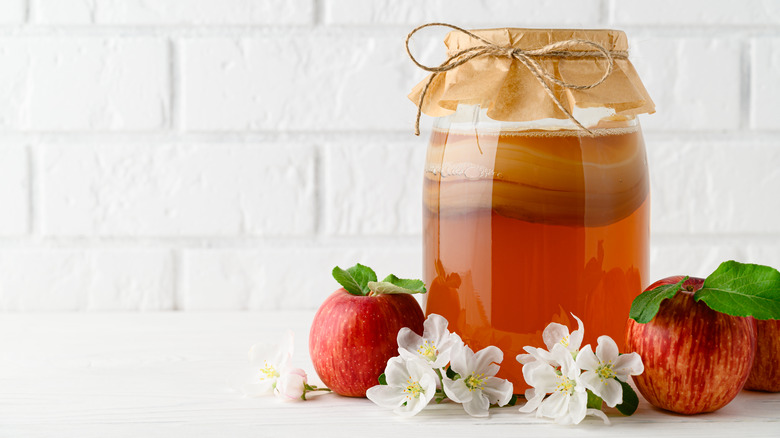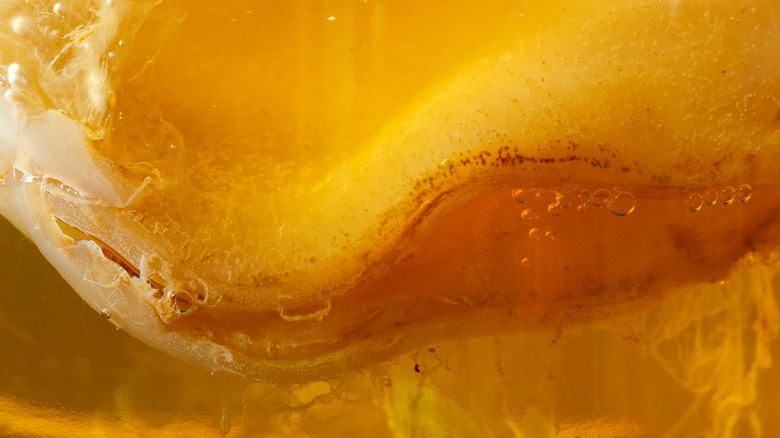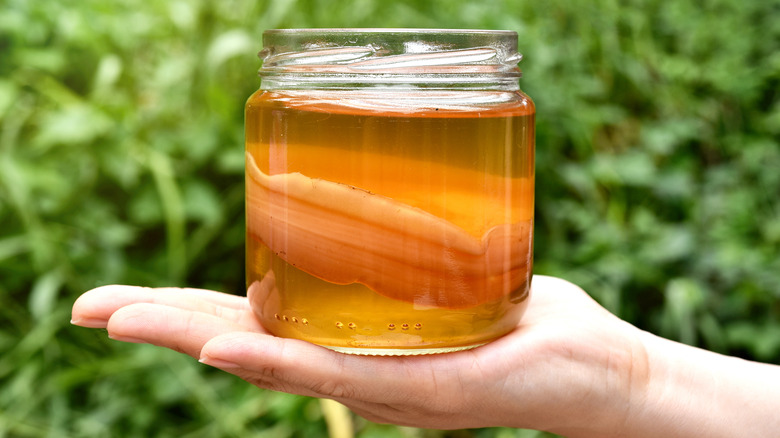Why Sugar Is A Crucial Component For Brewing Kombucha
If you've seen the viral video of Brittany Broski (the internet's very own "kombucha connoisseur") trying a sip of kombucha for the first time, or have tried the fermented drink yourself, you know that kombucha is a beverage with a complex flavor profile. From sour to sweet, a lot goes into the production of the drink that, according to The Food Institute, continues to gain immense popularity for its purported health benefits.
What exactly is kombucha? Simply put, kombucha is a special type of sweetened tea, per The Food Institute. The thing that sets kombucha apart from other brewed-tea beverages is that it is fermented via the cultivation of a floating mass called a SCOBY, which stands for "Symbiotic Culture of Bacteria and Yeast," according to Scientific American. The glob-like SCOBY can look kind of scary, but its role in the production of kombucha is quite magical.
The fermentation of the tea is what makes kombucha a probiotic, Healthline explains, and to help a SCOBY ferment kombucha successfully, it's important to understand the basics of the chemical process of fermentation.
How kombucha fermentation works
Fermentation plays a key role in the production of many delicious, nutritionally-dense foods around the world, from springy sourdough bread to spicy kimchi to tangy sauerkraut. But when looking at these fermented foods on a plate, the magical journey they took to get there is not so obvious.
Healthline explains that starches, sugars, and other carbs are transformed through fermentation into alcohol and acid, which in kombucha give the beverage its uniquely sour taste. The process essentially turns disparate ingredients into a complex ecosystem of growing, living bacteria that needs to be taken care of like any other organism in order to survive.
In kombucha, that ecosystem is the SCOBY. For fermentation to take place in the base of a kombucha tea, the healthy bacteria in a SCOBY need to be fed to keep activating the chemical process — and a SCOBY, like all yeast and bacteria, has a sweet tooth.
The SCOBY needs sugar to ferment
Despite it potentially being intimidating to keep a SCOBY alive and healthy, people make kombucha at home both to save money by not purchasing it bottled and because, like any culinary project, it can be rewarding and fun. Because of kombucha's reputation as a healthy drink, it can seem counterintuitive to add a lot of sugar when making it at home, but it's important to curb that instinct in order to keep that SCOBY happy. Remember, kombucha isn't just any normal tea, but a living, breathing science experiment.
When making kombucha at home, Kitchn suggests first brewing your tea of choice in hot, sugary water. Kitchn also advises against altering the amount of sugar in a kombucha recipe because that sugar isn't just acting as a flavor enhancer, but an important ingredient in the fermentation process. Without the suggested amount of sugar, your SCOBY might lose its ability to culture effectively, leaving you missing out on all the reasons you brewed kombucha instead of plain tea in the first place.
After your kombucha goes through its first fermentation process and you remove the SCOBY, it's okay to add in some flavorings before its second fermentation in a sealed bottle. Fresh fruits are a great option for flavoring your homemade kombucha because it offers even more fresh, natural sugars for the healthy bacteria to keep feeding and growing.
Happy, healthy, well-fed bacteria equals delicious, home-brewed kombucha!


